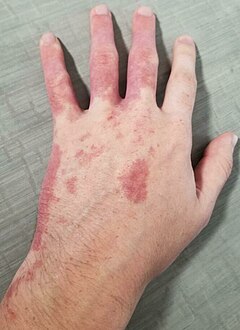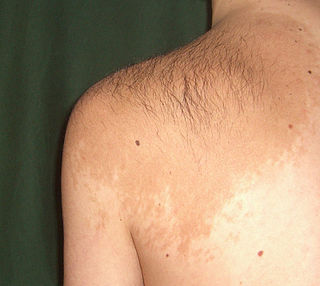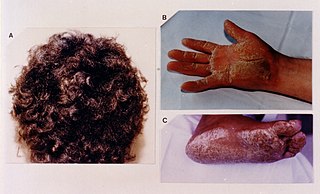| Woolly hair nevus | |
|---|---|
| Specialty | Medical genetics |
Woolly hair nevus (alternatively spelled "Wooly hair nevus") is a congenital condition in which hair in a circumscribed area of the scalp is kinked or woolly. [1]
| Woolly hair nevus | |
|---|---|
| Specialty | Medical genetics |
Woolly hair nevus (alternatively spelled "Wooly hair nevus") is a congenital condition in which hair in a circumscribed area of the scalp is kinked or woolly. [1]

A melanocytic nevus is a type of melanocytic tumor that contains nevus cells. Some sources equate the term mole with "melanocytic nevus", but there are also sources that equate the term mole with any nevus form.

A Mongolian spot, also known as slate grey nevus or congenital dermal melanocytosis, is a benign, flat, congenital birthmark with wavy borders and an irregular shape. In 1883, it was described and named after Mongolians by Erwin Bälz, a German anthropologist based in Japan, who erroneously believed it to be most prevalent among his Mongolian patients. It normally disappears three to five years after birth and almost always by puberty. The most common color is blue, although they can be blue-gray, blue-black or deep brown.

Nevus is a nonspecific medical term for a visible, circumscribed, chronic lesion of the skin or mucosa. The term originates from nævus, which is Latin for "birthmark"; however, a nevus can be either congenital or acquired. Common terms, including mole, birthmark, and beauty mark, are used to describe nevi, but these terms do not distinguish specific types of nevi from one another.

A port-wine stain is a discoloration of the human skin caused by a vascular anomaly. They are so named for their coloration, which is similar in color to port wine, a fortified red wine from Portugal.

A dysplastic nevus or atypical mole is a nevus (mole) whose appearance is different from that of common moles. In 1992, the NIH recommended that the term "dysplastic nevus" be avoided in favor of the term "atypical mole". An atypical mole may also be referred to as an atypical melanocytic nevus, atypical nevus, B-K mole, Clark's nevus, dysplastic melanocytic nevus, or nevus with architectural disorder.

The congenital melanocytic nevus is a type of melanocytic nevus found in infants at birth. This type of birthmark occurs in an estimated 1% of infants worldwide; it is located in the area of the head and neck 15% of the time.

Becker's nevus is a benign skin disorder predominantly affecting males. The nevus can be present at birth, but more often shows up around puberty. It generally first appears as an irregular pigmentation on the torso or upper arm, and gradually enlarges irregularly, becoming thickened and often hairy (hypertrichosis). The nevus is due to an overgrowth of the epidermis, pigment cells (melanocytes), and hair follicles. This form of nevus was first documented in 1948 by American dermatologist Samuel William Becker (1894–1964).

A blue nevus is a type of coloured mole, typically a single well-defined blue-black bump.

The Salish Wool Dog or Comox dog is an extinct breed of white, long-haired, Spitz-type dog that was developed and bred by the Coast Salish peoples of what is now Washington state and British Columbia. The small, long-haired wool dog and the coyote-like village dogs were deliberately maintained as separate populations. The dogs were kept in packs of about 12 to 20 animals, and fed primarily raw and cooked salmon. To keep the breed true to type and the preferred white color, Salish Wool Dogs were confined on islands and in gated caves.

The woolly mammoth is an extinct species of mammoth that lived during the Pleistocene until its extinction in the Holocene epoch. It was one of the last in a line of mammoth species, beginning with Mammuthus subplanifrons in the early Pliocene. The woolly mammoth began to diverge from the steppe mammoth about 800,000 years ago in East Asia. Its closest extant relative is the Asian elephant. DNA studies show that the Columbian mammoth was a hybrid between woolly mammoths and another lineage descended from steppe mammoths. The appearance and behaviour of this species are among the best studied of any prehistoric animal because of the discovery of frozen carcasses in Siberia and North America, as well as skeletons, teeth, stomach contents, dung, and depiction from life in prehistoric cave paintings. Mammoth remains had long been known in Asia before they became known to Europeans in the 17th century. The origin of these remains was long a matter of debate, and often explained as being remains of legendary creatures. The mammoth was identified as an extinct species of elephant by Georges Cuvier in 1796.

Nevus anemicus is a congenital disorder characterized by macules of varying size and shape that are paler than the surrounding skin and cannot be made red by trauma, cold, or heat. The paler area is due to the blood vessels within the area which are more sensitive to the body’s normal vasoconstricting chemicals.

Naxos disease is a cutaneous condition characterized by a palmoplantar keratoderma. The prevalence of the syndrome is up to 1 in every 1000 people in the Greek islands.
A benign melanocytic nevus is a cutaneous condition characterised by well-circumscribed, pigmented, round or ovoid lesions, generally measuring from 2 to 6 mm in diameter. A benign melanocytic nevus may feature hair or pigmentation as well.
Pseudomelanoma is a cutaneous condition in which melanotic skin lesions clinically resemble a superficial spreading melanoma at the site of a recent shave removal of a melanocytic nevus.

Woolly hair is a difficult to brush hair, usually present since birth and typically most severe in childhood. It has extreme curls and kinks and occurs in non-black people. The hairs come together to form tight locks, unlike in afro-textured hair, where the hairs remain individual. Woolly hair can be generalised over the whole scalp, when it tends to run in families, or it may involve just part of the scalp as in woolly hair nevus.
Hair follicle nevus is a cutaneous condition that presents as a small papule from which fine hairs protrude evenly from the surface.

Nevus depigmentosus is a loss of pigment in the skin which can be easily differentiated from vitiligo. Although age factor has not much involvement in the nevus depigmentosus but in about 19% of the cases these are noted at birth. Their size may however grow in proportion to growth of the body. The distribution is also fairly stable and are nonprogressive hypopigmented patches. The exact cause of nevus depigmentosus is still not clearly understood. A sporadic defect in the embryonic development has been suggested to be a causative factor. It has been described as "localised albinism", though this is incorrect.

Supernumerary nipples–uropathies–Becker's nevus syndrome is a skin condition that may be associated with genitourinary tract abnormalities. Supernumerary nipples, also referred to as polythelia or accessory nipples, is a pigmented lesion of the skin that is present at birth. This pigmentation usually occurs along the milk lines, which are the precursors to breast and nipple development. Clinically, this congenital condition is generally considered benign, but some studies have suggested there may be an association with kidney diseases and cancers of the urogenital system.